Steel manufacturers have been slow to embrace radio frequency identification technology. In addition to the usual barriers, including cost and a resistance to change, there has been concern that RFID doesn’t work on or near metal or in harsh environments. But like other manufacturers, steel producers are plagued by the inefficiencies that affect inventory, logistics and supply-chain management. So ThyssenKrupp Steel Europe, one of the world’s largest steel producers, ignored all the usual arguments for not deploying a new technology and, in 2007, announced it was using ultrahigh-frequency RFID tags to track 30-ton steel slabs from Brazil to its German processing factories.
This proved to be a solid investment and the beginning of the company’s engagement with the technology. Today, RFID forms the core of ThyssenKrupp’s centralized services solutions for tracking and tracing steel across a multinational supply chain composed of its own and third-party facilities in five locations: its plants in Duisburg, Germany, and Sepetiba, Brazil; a receiving factory in Alabama that ThyssenKrupp owned at the time; and cross-shipping seaports in Mobile, Alabama, and Rotterdam.

Since that initial deployment, vendors have developed a variety of RFID tags that work well on steel surfaces and embedded in steel products, says Loïc Feinbier, head of business process outsourcing management at ThyssenKrupp’s Global Shared Services group, who spearheaded the company’s first foray into RFID. But, he adds, rarely will the same tag suit every application and, in any case, getting the tag right is just part of the job. The rest is building a process around the technology. “That’s what makes steel today so hard and so much of an effort,” he says. “People are not necessarily willing to invest time and money to develop the solution.”
RFID also plays a role in improving operations at ThyssenKrupp’s factories, where steel slabs are turned into products, such as coils for the automotive industry. Other steel companies involved in manufacturing or finishing work are piloting RFID for inventory and supply-chain management. In addition, steel producers are improving customer service by tracking pipes and other structural steel products shipped to construction and oil and gas sites.
Linking the Steel Chains
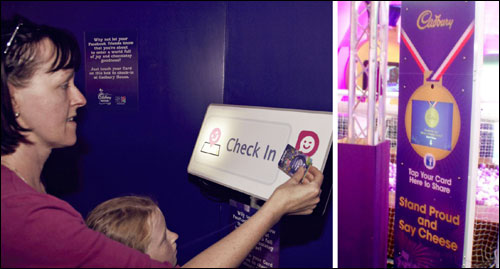
It took nearly three years from ThyssenKrupp’s initial pilot to develop a total solution, which addressed both technology and business issues. The company determined which RFID tags and readers to use, and how to affix them to objects to ensure identification accuracy. Each RFID tag is programmed with a unique identification number, based on GS1’s Serialized Global Trade Item Number (SGTIN) standard. Additional information, including steel grade and slab dimensions, is printed on the label. The work also required building applications, creating logic rules to drive down misreadings, and enabling IT systems integration capabilities that span its own and its partners’ systems, Feinbier says.
Developing a global solution presented several challenges, says Heiner Niehues, one of Feinbier’s first hires and now ThyssenKrupp’s head of supply-chain visibility/RFID. Each port through which steel shipments pass uses a different crane type, so reader-mounting installations had to be customized for each location, and ultrahigh frequencies and power emissions had to be optimized for use in different countries.
When large slabs of steel are being cross-shipped, “identification has to be real fast or a ship would lie longer in the port,” Niehues says. The longer it takes to unload a ship, the more costs add up. RFID offered real value over using bar codes or manual approaches to understanding inventory movements at ports.
Implementing RFID was a challenge, because it had to deliver speed and accuracy in a complex environment, with “assets coming out of chaotically organized storage in the vessel,” Feinbier says. “This took a massive amount of effort to figure out on our own because there was no leader or software in the market to do it.”
But today, all that effort has paid off: “We can see on a screen of a world map the second a slab is loaded or unloaded into or from a vessel—which crane reads the slab, which slab it is, and what is that slab’s history as it moves across the planet,” Feinbier says. With that information in hand, business rules in the software the company developed guide crane operators in moving the correct slab to the specified spot, for quick placement onto the designated railcar or barge. What ThyssenKrupp has done, he says, “really has worked out versus a lot of steel-environment apps that other companies have tried but which have disappeared because they couldn’t get them to work right or were too expensive.”
Forging Internal Operations
In 2014, ThyssenKrupp deployed an RFID system at two rolling mill factories, where steel rolls are turned into coils. It’s designed to ensure the rolls used for thinning pieces of metal—which are exchanged daily for maintenance—are replaced by the correct ones. The wrong combination could break the roll or damage the steel slab materials. “It’s about making 100 percent sure you don’t mix rolls up as surfaces and diameters matter to getting the right roll to the right production process,” Feinbier says.
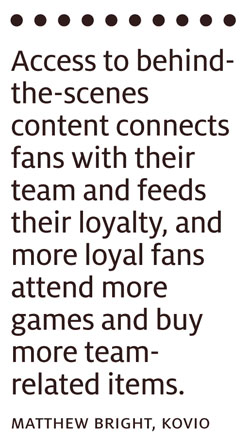
To ensure the match is accurate, a high-frequency RFID tag from Deister Electronics is embedded in each steel roll and identified by a Deister RFID reader installed on the rolling mill. “Most important in these apps is the resistance of the tags, because those rolls are turning very fast and are under heavy pressure because they’re pressing metal from two sides,” Feinbier says. “They also are exposed to heat because you create heat when you roll with massive pressure. The tags also are exposed to chemicals, oils and liquid—it’s a really harsh environment.”
In addition, employees equipped with RFID handheld readers can locate the tagged rolls in warehouses, which speeds up getting the correct materials moved to the rolling mill when they are needed, to avoid holding up projects. The handheld readers have built-in location positioning systems (LPS) for tying the XY coordinates of where a roll is stored to the RFID object identification information. (The warehouses are relatively small facilities, with at most a couple of hundred rolls in each.) Niehues expects this solution to be implemented at Thyssen-Krupp’s other production locations.
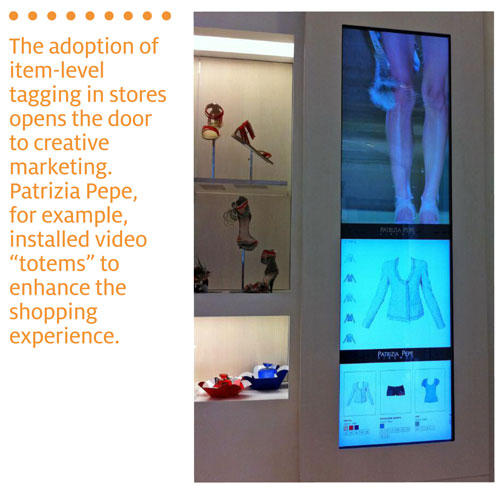
Silent Partner Technologies (SPT) is piloting a project with one of the largest pipe manufacturers in the world, Corinth Pipeworks S.A., headquartered in Athens. Corinth, whose business includes supplying steel pipe to the oil and gas industry, brings in and processes steel on a customer order basis, says SPT president Ted Kostis. Corinth is using UHF magnetic tags that attach to the inside of a pipe to manage inventory in the yard and improve shipping accuracy. At the end of processing, a worker uses a handheld reader to validate the right pipes are being sent to the customer, and then removes the tags for reuse on the next project—unless the customer wants to keep the tags to continue tracking on its own end, in which case it pays a fee to Corinth.
Each tag costs roughly $7, Kostis says, but “it is not a yard with a million pieces of pipe to store and track. Corinth might have only about 10,000 pieces of pipe at any given time on its site, and having less inventory to deal with leads to a significant reduction in RFID investment costs.”
TimkenSteel, a leading U.S. manufacturer of tailored alloy steel bars and seamless mechanical tubing, is employing UHF RFID technology to manage several internal processes. In 2009, the company worked with Lowry Solutions to implement a system to verify steel tubing shipments at its plant in Canton, Ohio. TimkenSteel produces hundreds of grades of steel, and some 200 trucks leave the plant each day. The goal was to take human error out of its client shipments. “The project wasn’t focused on costs–it’s focused on quality,” says Dave Haslar, TimkenSteel’s unit manager of shipping services. “We are just adding another layer to our protocols to ensure accurate shipping.”
Each bundle of steel tubing had a bar-code tag with a serial number assigned to a bill of lading, and TimkenSteel added an RFID chip to the tag. The tags are read when a driver exits the site through an RFID portal. Custom software matches the tag data to the bar-code serial number and associated bill of lading. If the process discovers an incorrect bundle, a light flashes on top of the building housing the RFID portal and an alarm alerts the driver to check the load.
Last year, the company began using RFID to manage shipments of its steel bars. It was easier to RFID-tag the steel tubing, because the tags hang off the bundles, but the bar-code tags are glued to the ends of the steel bar pieces. “It took a while to find an RFID tag that worked attached to the bars,” Haslar says. “If any part of the tag with the antenna touches steel, it grounds it out and it’s not readable.”
As of today, three TimkenSteel plants in the Canton area are using RFID to track shipments of both steel tubing and steel bars. The tags remain on the steel bundles, but customers are not yet taking advantage of the RFID possibilities, Haslar says. “We have had some inquiries, though,” he says, “and some customers may be looking to utilize RFID since it’s available now.”

After deploying RFID to manage steel tubing shipments, TimkenSteel installed RFID tags on its steel transport carriers to add an extra layer of safety. The system alerts employees that the trucks, which carry tubing, bars or supplies, are entering work areas, says Gregg Bond, TimkenSteel’s principal analyst for steel transportation.
Next, it installed RFID tags on steel haulers to identify the vehicles as they enter the scrap yard. Each hauler is weighed, and then software subtracts the actual vehicle weight from the total to determine how much scrap steel it is bringing in. “We get a fairly accurate reading of how much scrap comes into a yard, and that is important to keep track of how much internal scrap we generate and reprocess, from an inventory and accounting standpoint, he says.
Recently, TimkenSteel also began using RFID to track each of its 325 internal vehicles—forklifts, straddle carriers, pickup trucks and semis—for fueling purposes. Readers at each fueling station read the tag on each truck to identify what type of truck it is and ensure that it is at the right fuel pump or area, Bond says.
Age Steel, a United Arab Emirates company that operates multiple steel yards, deployed an innovative RFID solution to improve inventory management. The company mounted an RFID reader on a drone as part of its Steel Yard Autonomous Tracking solution to quickly and accurately track the locations of pipes, plates and other metal products stored in the steel yards it operates in Dubai.
Standardization—True as Steel
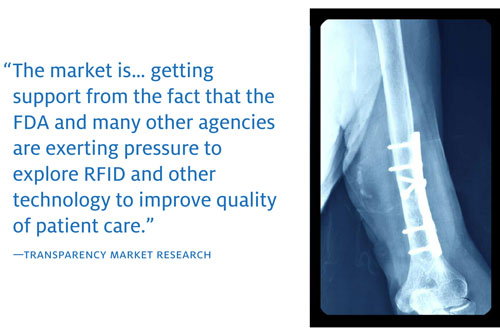
Early on, ThyssenKrupp recognized the need for technology standards in the steel industry. Speaking at RFID Journal LIVE! Europe in 2008, Feinbier said, “Standardization is crucial,” explaining it would lead to low-cost solutions, and provide flexibility to integrate with new customers and suppliers.
Among the decisions ThyssenKrupp made was for all its software applications to be based on the Electronic Product Code Information Services (EPCIS) standard. EPCIS provides a universal business language that has helped the company expand its RFID initiative, whether it’s collecting data to provide visibility at a seaport or a rolling mill warehouse.
Recently, for example, ThyssenKrupp introduced a mobile application that allows third-party slab suppliers anywhere in the world to identify their slabs with RFID labels. All they need, Niehues says, is a computer and printer; after downloading the app, they can print UHF RFID labels locally.
The application benefits the Alabama factory, originally owned by ThyssenKrupp, which was configured to receive materials using RFID for the greatest efficiency. The facility now sources slabs from other suppliers as well as ThyssenKrupp, and it can use RFID to receive all materials. “That’s really important, because the whole internal logistics of that factory with respect to slabs now depends on RFID technology,” Niehues says.
Steeling the Industry for the Future
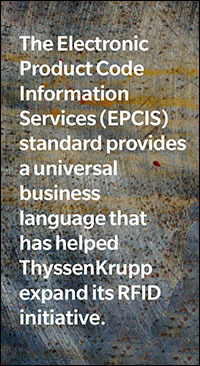
OCTG Tubular Finishing is employing UHF RFID technology to track the steel pipes, also known as tubes, it inspects and finishes at a facility near Houston, Texas, before they are shipped to oil-drilling sites. The company worked with SPT, its RFID solutions provider, to track the pipes from OCTG’s yard to the time they entered a drill hole. The goal was to provide supply-chain visibility for inventory management at the finishing facility and at drill sites, and to trace an inoperable pipe to determine where and how the problem occurred.
OCTG and SPT formed a joint venture called Oil Country Asset Management (OCAM), to sell the pipe-tracking solution to supply-chain partners—oil-field operations companies and steel mill customers, as well as other steel finishers. Many steel yards and finishers have hundreds of thousands of pipes on site, all of them still owned by the steel mills.
For now, though, the OCAM venture is on hold. Blame it on the cost of the magnetic tag, Kostis says. “When it’s a raw steel pipe with no end cap on it, and the pipe hasn’t been treated or inspected yet, going through sandblasting, painting, ultrasonic testing and other processes, you’d have to use the embedded magnetic version,” he says.
The tags can be removed before a pipe enters a drill hole for reuse, but, Kostis says, the cost is too high for steel mills to eat, even considering the potential return on investment of more efficient inventory management. OCTG receives daily calls from steel mills requesting inventory counts. Another option, he says, is to use a 30-cent, nonreusable tag that can be attached to a pipe’s end cap once the finishing processes are concluded. It could be used for supply-chain tracking, but the finisher wouldn’t get the benefits of automated onsite counting of the pipes from the moment they enter its yard.
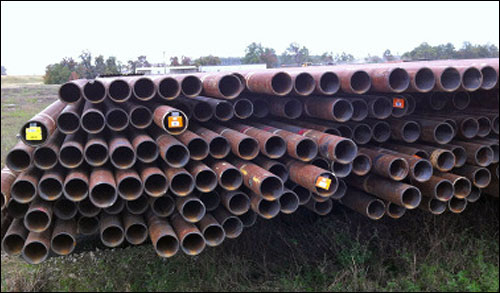
Collaboration between manufacturers and finishers could make the cost more digestible, Kostis says. In addition, each supply-chain partner could use RFID to improve other inefficiencies. OCTG, for example, is using RFID for access control and to enable managers to see exactly how many employees are available to accomplish a specific task. The company is also tracking the location of tools to avoid production delays.
Clearly, ThyssenKrupp and other steel manufacturers and suppliers are seeing an ROI from the time and money they’ve invested in developing RFID solutions. But they’d like RFID providers to do a better job developing and marketing solutions specifically for the steel industry, to promote adoption and drive down costs. “In any kind of steel production, there are so many apps that you can think of,” Feinbier says. “The key thing around steel is that for any single app that you can think of, you have to start from scratch. There barely are any solutions out there.”
The Competitive Advantage
RFID is helping steel companies win contracts and improve customer service.
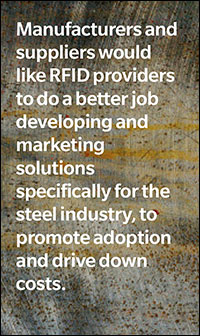
Since 2009, Gammon Construction’s Gammon Steel, a Hong Kong provider of structural steelwork services, has been using RFID to track components and products in its factory and en route to construction sites. Gammon Steel attaches a Xerafy Bric rugged tag, specifically designed to be embedded in concrete, to metal support rods by cable ties. The tag is ideal for tracking modular construction assets such as prefabricated building pieces and for supporting regulatory checks and maintenance, says Xerafy CEO Dennis Khoo That’s increasingly important for construction companies, especially in Asia, sourcing steel from China, he says.
“It’s not so obvious from the start that you have shoddy quality,” Khoo says, “but it starts to show after awhile.” RFID provides a record of where materials came from so the quality issues can be monitored and addressed. The Hong Kong Housing Authority, for example, has instituted a value-added component to public construction project tenders that award extra points to companies that plan to use RFID for facility management, even though that typically raises the bid price.
“RFID lets the government automate quality control, materials management and communication,” Khoo says. “RFID also facilitates supplier check audit and an easier ability to control project delays and cost overruns. In the past, they would have to rely on paperwork and humans to record and track and trace. RFID simplifies the whole process and allows them to be able to trace things back to the supplier if there is a quality issue.”
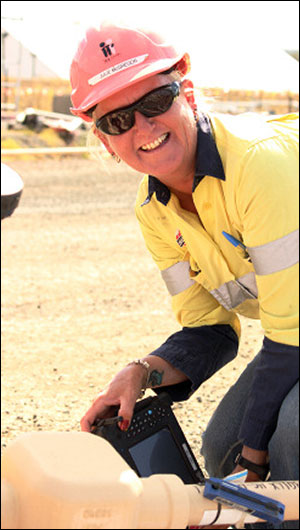
—Matthew Saunders, procurement operations manager, Curtis Island projects (Photo: Bechtel)
Bechtel, the engineering and construction giant, is building three liquefied natural gas processing and export facilities on Curtis Island, off the coast of Gladstone, Australia. It’s been RFID-tagging materials at its laydown (storage) sites on the mainland, to ensure the correct items are sent to each construction site. Last spring, when RFID Journal published a story about the deployment, Bechtel said it was working hard to increase partner involvement, and that some fabricators were tagging items before shipping.
“Efficiency gains were achieved by having tags fixed at pipe shop fabricators prior to shipping,” says Matthew Saunders, procurement operations manager, Curtis Island projects. “This allowed for an expedited receipt upon arrival and enabled the material to be placed quickly in laydowns unobstructed. There was no latency in processing, as the tags would be read by the vehicle-mounted reader to capture inventory location. There is a definite benefit to having the tags fixed upstream in the supply chain so products arrive ready for use.”

